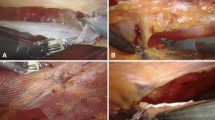Abstract
Background
The evolution of midline ventral hernia repair has progressed from the open Rives-Stoppa technique to minimally invasive robotic approaches, notably the trans-abdominal retromuscular (TARM) and enhanced-view Totally Extraperitoneal (eTEP) methods. This study compares these two robotic techniques in repairing medium-sized midline ventral hernias.
Methods
A retrospective comparative study of electronic medical records from 2015 to 2021 was conducted on patients undergoing robotic TARM or eTEP at NYU Langone Hospital—Long Island. Data on demographics, comorbid conditions, surgical history, intraoperative details, hernia characteristics, and postoperative outcomes were analyzed.
Results
Both eTEP and TARM groups exhibited comparable outcomes regarding operative duration, hernia defect size, and overall complications. However, notable differences were observed in patients’ BMI, implanted mesh area, mesh composition, and fixation techniques across the groups. The TARM group required a longer hospital stay (median: 1 day) in contrast to the eTEP group (median: 0 days). Additionally, eTEP patients indicated reduced postoperative pain scores (median: 2) compared to TARM (median: 3), with both differences being statistically significant (p < 0.001).
Conclusion
The robotic eTEP approach is associated with lower post-operative pain scores, decreased hospital length of stay, and larger areas of mesh implantation as compared to the TARM approach. Other variables are largely comparable between the two techniques.
Level of evidence
Level III.



Similar content being viewed by others
Data availability
Not applicable.
Abbreviations
- BMI:
-
Body Mass Index
- CAD:
-
Coronary Artery Disease
- COPD:
-
Chronic Obstructive Pulmonary Disease
- CRI:
-
Chronic Renal Insufficiency
- CT:
-
Computed Tomography
- DM:
-
Diabetes Mellitus
- EBL:
-
Estimated Blood Loss
- ED:
-
Emergency Department
- eTEP:
-
Enhanced-view totally extraperitoneal
- HTN:
-
Hypertension
- LOS:
-
Length of Stay
- NYU:
-
New York University
- SD:
-
Standard Deviation
- SSI:
-
Surgical Site Infection
- SSO:
-
Surgical site occurrence
- SSOPI:
-
Surgical site occurrence requiring procedural intervention
- POST-OP:
-
Postoperative
- TARM:
-
Trans-abdominal retromuscular
- VAS:
-
Visual Analogue Scale
References
Ventral Hernia Working Group, Breuing K, Butler CE, Ferzoco S, Franz M, Hultman CS, Kilbridge JF, Rosen M, Silverman RP, Vargo D (2010) Incisional ventral hernias: review of the literature and recommendations regarding the grading and technique of repair. Surgery 148(3):544–558. https://doi.org/10.1016/j.surg.2010.01.008
Masurkar AA (2020) Laparoscopic Trans-Abdominal Retromuscular (TARM) Repair for ventral hernia: a novel, low-cost technique for sublay and posterior component separation. World J Surg 44(4):1081–1085. https://doi.org/10.1007/s00268-019-05298-z
Santos DA, Limmer AR, Gibson HM, Ledet CR (2021) The current state of robotic retromuscular repairs-a qualitative review of the literature. Surg Endosc 35(1):456–466. https://doi.org/10.1007/s00464-020-07957-y
Belyansky I, Reza Zahiri H, Sanford Z, Weltz AS, Park A (2018) Early operative outcomes of endoscopic (eTEP access) robotic-assisted retromuscular abdominal wall hernia repair. Hernia: J Hernias Abdom Wall Surg 22(5):837–847. https://doi.org/10.1007/s10029-018-1795-z
Baig SJ, Priya P (2019) Extended totally extraperitoneal repair (eTEP) for ventral hernias: short-term results from a single centre. J Minim Access Surg 15(3):198–203. https://doi.org/10.4103/jmas.JMAS_29_18
Carbonell A (2018) The 9th annual abdominal wall reconstruction summit, Montana, USA
Haskins IN, Horne CM, Krpata DM, Prabhu AS, Tastaldi L, Perez AJ, Rosenblatt S, Poulose BK, Rosen MJ (2018) A call for standardization of wound events reporting following ventral hernia repair. Hernia: J Hernias Abdom Wall Surg 22(5):729–736. https://doi.org/10.1007/s10029-018-1748-6
Addo A, Lu R, Broda A, George P, Zahiri HR, Belyansky I (2021) Hybrid versus open retromuscular abdominal wall repair: early outcomes. Surg Endosc 35(10):5593–5598. https://doi.org/10.1007/s00464-020-08060-y
Zaman J, Teixeira L, Patel PB, Ridler G, Ata A, Singh TP (2023) From transabdominal to totally extra-peritoneal robotic ventral hernia repair: observations and outcomes. Hernia: J Hernias Abdom Wall Surg 27(3):635–643. https://doi.org/10.1007/s10029-023-02767-2
Rege SA, Churiwala JJ, A Kaderi AS, Kshirsagar KF, Dalvi AN (2021) Comparison of efficacy and safety of the enhanced-view totally extraperitoneal (eTEP) and transabdominal (TARM) minimal access techniques for retromuscular placement of prosthesis in the treatment of irreducible midline ventral hernia. J Minim Access Surg 17(4):519–524. https://doi.org/10.4103/jmas.JMAS_145_20
Andreuccetti J, Sartori A, Lauro E, Crepaz L, Sanna S, Pignata G, Bracale U, Di Leo A (2021) Extended totally extraperitoneal Rives-Stoppa (eTEP-RS) technique for ventral hernia: initial experience of The Wall Hernia Group and a surgical technique update. Updat Surg 73(5):1955–1961. https://doi.org/10.1007/s13304-021-01067-7
Kudsi OY, Chang K, Bou-Ayash N, Gokcal F (2020) Transabdominal (TA) versus totally extraperitoneal (TEP) robotic retromuscular ventral hernia repair: a propensity score matching analysis. Surg Endosc 34(8):3550–3559. https://doi.org/10.1007/s00464-020-07574-9
Yang GP (2017) Laparoscopy in emergency hernia repair. Annals Laparosc Endosc Surg 2(6):23.
Halpern DK, Liu H, Amodu LI, Weinman K, Akerman M, Petrone P (2023) Long term outcomes of robotic-assisted abdominal wall reconstruction: a single surgeon experience. Hernia: J Hernias Abdom Wall Surg 27(3):645–656. https://doi.org/10.1007/s10029-023-02774-3
Author information
Authors and Affiliations
Corresponding author
Ethics declarations
Conflict of interest
The authors declare that they have no conflict of interest.
Ethical approval
Not applicable as this manuscript does not involve any active research on humans or animals.
Human and Animal Rights
This article does not contain any studies with human participants or animals performed by any of the authors.
Informed consent
For this type of study formal consent is not required.
Additional information
Publisher's Note
Springer Nature remains neutral with regard to jurisdictional claims in published maps and institutional affiliations.
Rights and permissions
Springer Nature or its licensor (e.g. a society or other partner) holds exclusive rights to this article under a publishing agreement with the author(s) or other rightsholder(s); author self-archiving of the accepted manuscript version of this article is solely governed by the terms of such publishing agreement and applicable law.
About this article
Cite this article
Pacheco, T.B.S., Hakmi, H., Halpern, R. et al. A comparison of robotic enhanced-view totally extraperitoneal approach versus trans-abdominal retro-muscular approach for midline ventral hernias. Hernia (2024). https://doi.org/10.1007/s10029-024-03042-8
Received:
Accepted:
Published:
DOI: https://doi.org/10.1007/s10029-024-03042-8




